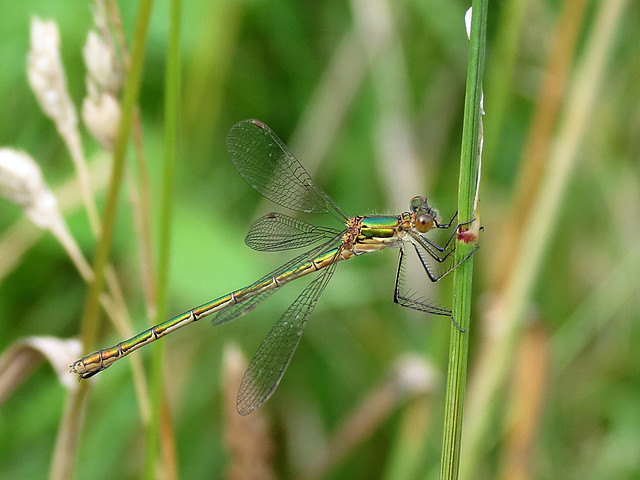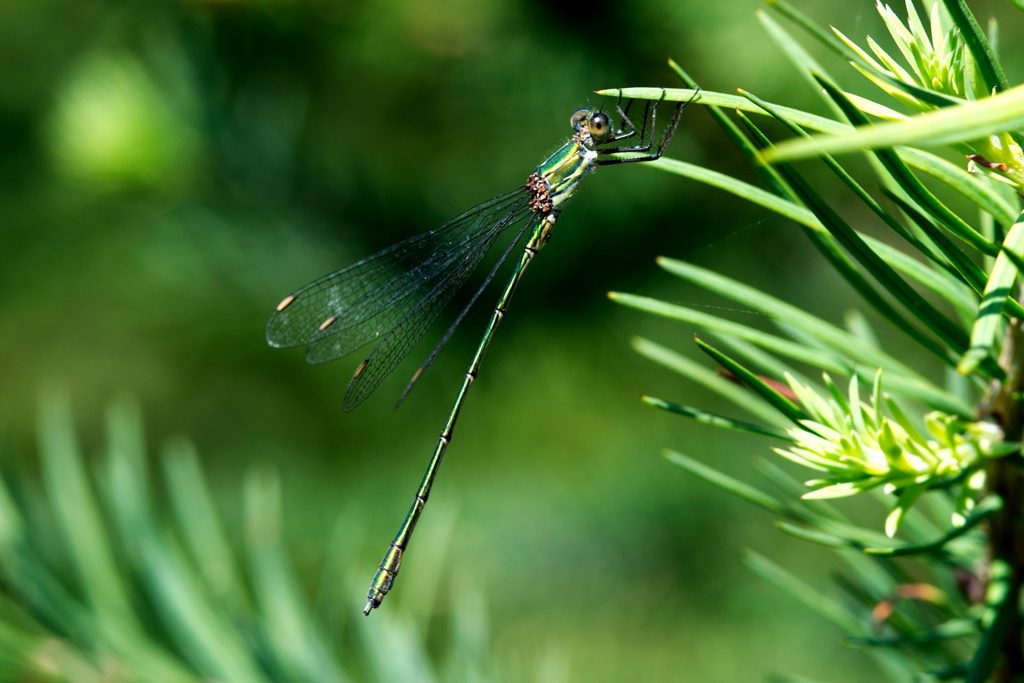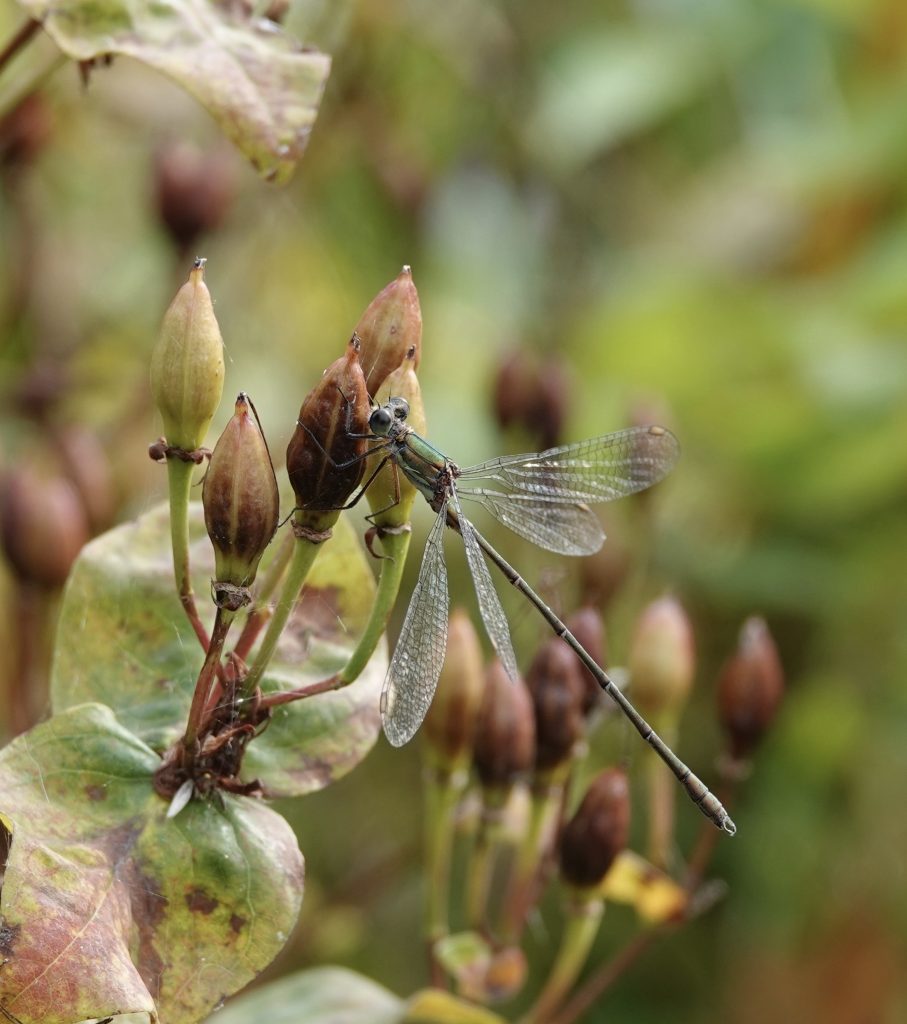<-Previous Species – Next Species->
Vagrant species with one record from Shirley Pool. Askern.
www.yorkshiredragonflies.org.uk
<-Previous Species – Next Species->
Vagrant species with one record from Shirley Pool. Askern.
<-Previous Species – Next Species->
A mainly scarce migrant, though regular at some key sites may suggest local breeding.
45-49mm; Wingspan: Male 58mm; Female 63mm; Hindwing 24-36mm; Larva: 30-35mm
Dark brown-black wings, with iridescent blue veins making the wings appear metallic cobalt blue. Extreme tips and bases may be paler, there is no pterostigma. Wings are broader than the similar Banded Demoiselle. Body is metallic blue-green. Immatures wings are browner.
Dark brown iridescent wings with a white ‘false pterostigma’, larger on forewing than hindwing. Wings are browner than the similar Banded Demoiselle. Body is metallic green with a bronze tip to abdomen. Homeochrome, (male coloured females) are sometimes recorded.
Territorial males perch on bankside vegetation. They will flick their wings open and shut, occasionally chasing off passing insects, often returning to same perch. Females only visit water for egg-laying or seeking a mate, both sexes frequently stray well away from water. Flies slowly with a butterfly like flight and frequently settles on bankside vegetation or trees.
Restricted to faster running clear water, found only along streams and rivers, often acidic, with sand or gravel bottom. Mostly found along heathland or moorland streams, though can also occur in farmland and woodland, including well shaded streams. Prefers cooler water than Banded Demoiselle. As streams broaden this species gives way to Banded Demoiselle, where there may be a broad overlap. Occasional hybridisation may take place. Sensitive to waterway management (clearance of vegetation) and pollution.
VC61 – Only finds its way into the Vice-county due to the new course of the River Hertford being cut south of the old North and East Riding County Boundary. In many places this is within metres of the boundary.
VC62 – Extremely localised to the south-eastern area of the North Yorkshire Moors.
<-Previous Species – Next Species->
45-48mm; Wingspan: Male 61mm; Female 65mm; Hindwing 27-36mm; Larva: 30-40mm
Translucent wings with a broad, dark iridescent blue-black band on outer part of both wings, there is no pterostigma. Body is metallic blue-green. Immatures wing band is dark brown.
Translucent pale green wings, white ‘false pterostigma’, larger on forewing than hindwing, metallic green body. Sometimes androchrome females are observed (male coloured females), these can be identified by the ‘false pterostigma’ which males lack.
Males are territorial, though large numbers can be found together. They attract females by flicking their wings open whilst performing an aerial dance in front of them, flopping down on to the egg-laying site. Females stay away from water unless looking for a mate or egg-laying. Adults will make use of nettle beds and tall grasses to rest.
Mature, slow-flowing streams, rivers and canals, with muddy sediment. Can overlap with Beautiful Demoiselle where habitat contains patches of sand and gravel. Prefers open banksides, where as Beautiful Demoiselle will happily use shady areas. Adults of both sexes can be found well away from water and ponds where breeding is unlikely, thought they will breed in lakes adjacent to rivers. Sensitive to waterway management (clearance of vegetation) and pollution.
Abundant along occupied rivers and streams.
<-Previous Species – Next Species->
35-39mm; Wingspan: Male 42mm; Female 45mm; Hindwing 19-22mm

Metallic green in colour. This species has a slow maturation period of two to four weeks, over this period a blue pruinescence appears on the thorax between wings and segments 1,2, 9 and 10. Eyes blue. Confusion species is Scarce Emerald Damselfly which is extinct in Yorkshire. Both sexes rest with wings half open.

Metallic green, with pale beige sides to the thorax. Distinctly thicker abdomen than male.
Weak flyer usually remaining close to emergent vegetation, rarely going far over water. Copulation usually takes place close to breeding site and last from 30 minutes to over an hour. Females usually arrive to oviposit in tandem with the male. Oviposits in to stems of emergent grasses, rushes, sedges and horsetails, usually above surface, but can submerge, including the male. Fairly sedentary and can be absent from seemingly good sites.
Still or slow moving water such as ponds, bogs, ditches, canals and lake edges with dense emergent vegetation. Tolerates brackish and acidic water. Sensitive to excessive clearance of emergent vegetation.
Found at many sites through all Vice-counties.
<-Previous Species – Next Species->
A recent colonist, the first record in 2019 coming from Harwood Dale, North Yorkshire.
 First record for Yorkshire at Harwood Dale, courtesy of Steve Beevers
First record for Yorkshire at Harwood Dale, courtesy of Steve Beevers
 Photo courtesy of Keith Gittens
Photo courtesy of Keith Gittens
<-Previous Species – Next Species->
Only records concerns those from 1951/52 at Long Bank Dyke, Kilnsea and one site in South-west Yorkshire.
<-Previous Species – Next Species->
33-36mm; Wingspan: Male 44mm; Female 48mm; Hindwing 19-24mm
The only red damselfly in Yorkshire and unlikely to be mistaken for anything else. Red abdomen, with black bands on segments 7 to 9. Thorax is black on the top with a red stripe (yellow in immatures). Black areas have a bronze tint.
Male
Occurs in three colour forms. The commonest form is typica, with black bands on most segments of the abdomen. Fulvipes is less well marked than typica and closely resembles the male. Melanotum is a dark from being mainly black, however the antehumeral stripes remain yellow (only yellow when immature in other forms).
Female – typica
This is the first damselfly to emerge each year in Yorkshire. It has a synchronous emergence, all emerging within a three week period, it is therefore shortly after emergence that this species is most abundant. Males emerge slightly earlier than females and also mature more quickly. Copulation lasts for around 15-20 minutes. Eggs are laid in tandem, the female may submerge taking the male with her. The life cycle is two years, on initially occupying a new site there may therefore only be adults found every other year.
Has a wide habitat tolerance, including brackish and slightly polluted water, though avoids fast flowing water. Higher abundance in well vegetated, standing water.
Evenly distributed across VC61-64, scarcer in VC65.
<-Previous Species – Next Species->
33-37mm; Wingspan: Male 43mm; Female 46mm; Hindwing 19-24mm
Mainly bronzed black with bright red eyes. Top of thorax lacking any antehumeral stripes. Segments 1, 9 and 10 are blue. Sides of thorax are blue with black line and spur present. Legs are black. Immature male is similar to female. Similar to Small Red-eyed Damselfly which is smaller, differences occur in the blue markings. At rest the wing tips reach in to segment eight, in Small Red-eyed Damselfly the wing tips only reach as far as segment 6 or 7. Generally holds its abdomen level, where as Small Red-eyed Damselfly often holds its abdomen slightly upcurved towards the end.
Mainly black with green sides to thorax containing black line and spur. Segments 9 and 10 are black with narrow blue divisions. Eyes are a dull red colour. Usually have short shoulder stripes, though some lack them all together and some may form as explanation marks.
Strong direct flight over water. Spend lots of time resting on broad floating leaves such as water lilies. Mats of algae and debris are also used and males may use surrounding shrubs if there is little floating vegetation. After emergence they will spend time away from water to mature. The first three weeks of emergence is probably the best time to encounter this species at close quarters. Females usually only appear at water to breed. Copulation takes place over water or on nearby vegetation. Egg laying is mainly in tandem, both sexes often submerging. They are laid mainly on the underside of Water Lilies, though other floating vegetation will be used.
Preference for larger ponds, lakes and canals. Requires abundant floating vegetation, such as water-lilies Nymphaceae, or broad-leaved pondweed Potamogeton natans. When these are absent it may use floating algae mats, or rest on bankside vegetation.
Species is at the northern edge of its range in Yorkshire.